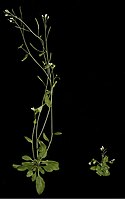
Photo from wikipedia
Abstract A potential barrier to the establishment of weed biological control agents is interference from other management tactics that induce plant defenses. Methods that suppress the weed such as feeding… Click to show full abstract
Abstract A potential barrier to the establishment of weed biological control agents is interference from other management tactics that induce plant defenses. Methods that suppress the weed such as feeding by other biological control agents or mechanical removal are especially disposed to inducing plant defenses and potentially limiting agent establishment. Here, we focused on the invasive weed Lygodium microphyllum (Cav.) R. Br. (Schizaeales: Lygodiaceae, Old World climbing fern) and one of its biological control agents, the mite Floracarus perrepae Knihinicki and Boczek (Acariformes: Eriophyidae). We experimentally induced plant defenses in potted plants via damage or application of jasmonic acid, a hormone typically involved in plant defenses, and measured the responses of the mite in a screenhouse. Localized damage to the pinnae (e.g., leaflets) via cutting or larval feeding from a second biological control agent, Neomusotima conspurcatalis (Warren) (Lepidoptera; Crambidae), reduced F. perrepae gall formation, but not the number of mites per gall. In contrast, damage to rachises (e.g., stems) did not affect galling, likely because plant defense responses were not systemic. Application of jasmonic acid reduced gall formation but not the numbers of mites within galls. Taken together, we found that localized damage interfered with gall formation but not within-gall reproduction. However, these effects on the mite from induced plant defenses are likely short-lived, and therefore interference between management tactics is unlikely to affect F. perrepae establishment and performance.
Journal Title: Environmental Entomology
Year Published: 2021
Link to full text (if available)
Share on Social Media: Sign Up to like & get
recommendations!